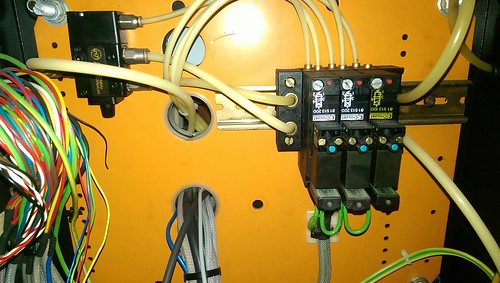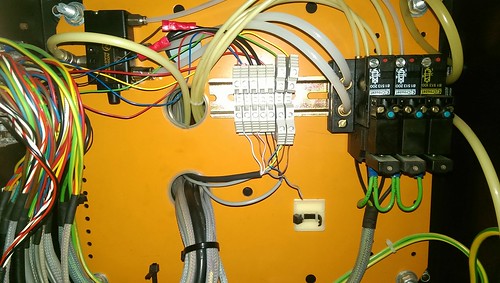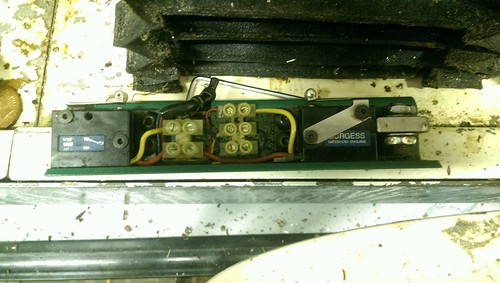Hybrid View
-
04-12-2016 #1
I read your description of your e-stop, etc, wiring with interest. Always good to see someone else's approach. Couple of questions come to mind.
Did you consider use of a safety relay? I managed to pick up one cheap on eBay, partly because it lets me switch a number of circuits from the e-stop switch, convenient way to configure "momentary contact" standby switch, etc. Does your e-stop connect to a latching relay or similar?
You mention limit switch triggering as equivalent to e-stop. I can see why you might want to do this, but will it give problems in separating limit and home switch operation? I use drive fault from my digital drives to trigger e-stop but limit/home switches go direct to CSMIO (similar argument to yours re dedicated firmware - no PC involvement).
-
04-12-2016 #2
Technically to meet the latest regs, I should use a proper E-stop relay, however it's something I've not bothered with yet, and as I'll be the only person using the machine, I technically don't need to conform to any regulations.
However, the main reason is I'd need to add an enable button, and the control panel is still a sketch in a notepad at the moment. It's something I will likely add at a later date, once I have fully functional control panel.
The real benefit of a E-stop relay is the contact monitoring, whereby should a contact stick/weld shut, it won't enable.
I always use separate home switches, so homing is not a problem. I personally think it's a waste of inputs wiring the limits directly to the controller, as there is little benefit. If you can't tell what switch you've just ran into, you're doing something wrong!You mention limit switch triggering as equivalent to e-stop. I can see why you might want to do this, but will it give problems in separating limit and home switch operation? I use drive fault from my digital drives to trigger e-stop but limit/home switches go direct to CSMIO (similar argument to yours re dedicated firmware - no PC involvement).
What I do have though, is all the limit switches and everything else in the E-stop circuit, pass through a row of DIN rail terminal blocks, so should something fail, 30 seconds with a multimeter lets me know where the problem is. I do take the Drive fault signals to the controller, as it lets me know what drive has failed, for the reason I need to turn the cabinet power of before I can open the cabinet at which point the drives get reset.
As always, there are several ways to achieve this. The main thing to consider with any system, is what would happen in the worst case scenario, should any/multiple parts of the system fail.Avoiding the rubbish customer service from AluminiumWarehouse since July '13.
-
04-12-2016 #3
I don't class Limits as Emergency stop condition. They are positional errors which if talking directly to Controller and not relying on software can be handled by controller/drives safely with out any need to kill power. Soon becomes pain in the arse reseting if when approaching travel limits you accidentally trip limit.
-
05-12-2016 #4
You can argue both ways, but Denfords have the limit switches as part of the E-stop circuit as standard, and I don't see any point in changing it.
Provided you have soft limits working correctly, you should never hit a limit switch anyway, so if you do, it's because something has gone wrong.Avoiding the rubbish customer service from AluminiumWarehouse since July '13.
-
05-12-2016 #5
Yes you can and for long time I did it your way but changed my thinking over time. However don't fully agree on the softlimits point.?
Softlimits are only useful provided machine was homed first and sadly most control Software will allow you to do that. If someone forgets to home then they are completely useless.
Cslabs have nice feature where if soflimits are on then machine can't be Jogged when controller first switched on. This much safer and how it should be done IMO even without Soflimits.
-
06-12-2016 #6
Soft limits are a great idea but as Jazz has said they need a reference point. All of our newer industrial machines at work require a reference before you can do anything with them. The machines cant even be jogged around. Obviously this is because once referenced all of the soft limits for table positions and dimensions and limits are taken from the reference point. The machine still has limit switches at the ends of the track and between tables.
-
25-12-2016 #7
Ignoring the soft limit debate for now, which I will revisit when I get onto configuring the KFlop, I'll do a little bit more on wiring.
Now that the new home switches are installed, I had to wire them into the controller.
The original wiring for the 2 wire home switches, had two of the sensors common wires doubled up, and everything else on separate pins in the main machine connector, so the original sensors used a total of 5 pins.
For the new 3 wire sensors, I needed 2 power wires, and 3 signal wires, so the same number of wires were needed.
One thing I hate is connecting multiple wires into single terminals. Although it will work, it makes future replacement and testing harder. Luckily the Triac has an extra enclosure on the rear of the machine for the pneumatics, which originally looked like this -

After sliding the solenoid block along, and extending some of the tubing, we end up with plenty room for some terminal blocks-

The two double height blocks provide a GND and 24V supply for on the machine, which the new home switches use. It also gives a convenient connection point for future additions that need 24V.
The extra two blocks are for the X-axis limit switch connections, so all the X-axis cable connections are in the same place.
And now I've found a picture, here's the original X-axis switch setup-

Unfortunately I never took a picture of the new setup, but the only difference is a new proximity sensor, and the two way terminal block swapped to a three way. I could of used the existing setup just by soldering the limit switch common wires together, but why do that when you can make life even more awkward and fiddly for yourself?
Which while I'm on wiring, brings me to bootlace ferrules.
One thing that often results in untidy wiring, are stray wire strands at connectors. Especially once a wire has been removed and put back in a couple times, the problem usually gets worse.
A bootlace ferrule, not only keeps things tidier, it also provides support for the wire, and makes inserting wiring into terminals easier.
On thin wiring, such as is normally found on sensors, this makes a big difference, as you'll often find once a thin wire has been removed and reinserted a couple times, several of the strands will get broken, so you have to cut back the wire. Using a ferrule pretty much eliminates that problem.Avoiding the rubbish customer service from AluminiumWarehouse since July '13.
-
The Following User Says Thank You to m_c For This Useful Post:
Thread Information
Users Browsing this Thread
There are currently 1 users browsing this thread. (0 members and 1 guests)
Similar Threads
-
Denford Triac - Help
By mikeadams1985 in forum Denford MillsReplies: 1Last Post: 12-01-2017, 10:06 AM -
FOR SALE: Denford Triac CNC PC
By ricey3 in forum Items For SaleReplies: 6Last Post: 10-01-2017, 01:39 PM -
Denford Triac VMC
By fidia in forum Milling Machines, Builds & ConversionsReplies: 6Last Post: 19-08-2016, 08:18 AM -
Help Denford triac p.c.
By mikeulike in forum Denford MillsReplies: 3Last Post: 02-06-2015, 03:59 PM -
WANTED: Denford Triac
By edwardsjc in forum Items WantedReplies: 13Last Post: 20-08-2012, 08:17 AM










 Reply With Quote
Reply With Quote


Bookmarks